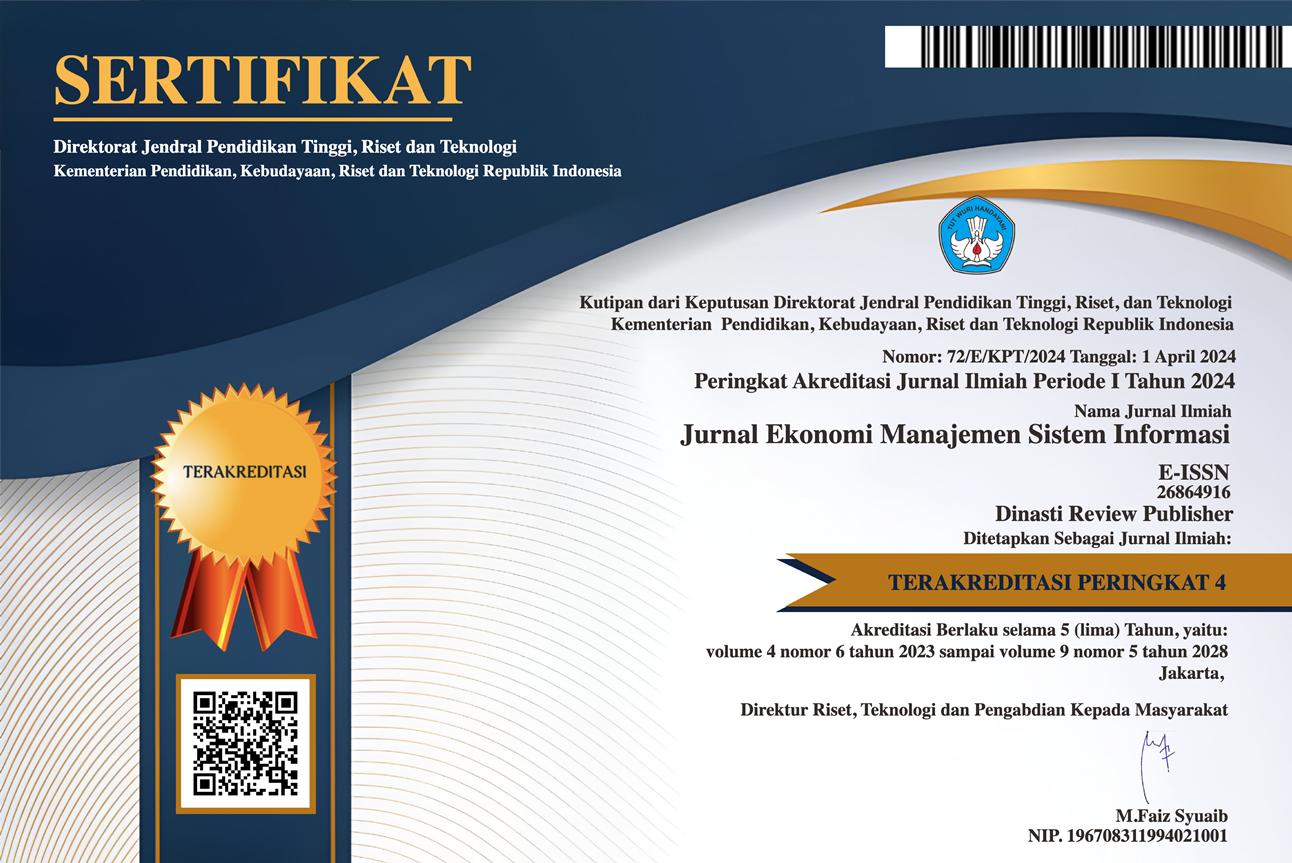Digital Marketing Strategies to Increase Customer Purchase Decisions in the Frozen Food Industry: A Case Study of the Sunny Gold Brand
DOI:
https://doi.org/10.38035/jemsi.v6i5.5332Keywords:
Digital Marketing Strategy, Customer Purchase Decisions, Brand Image, Social Media Marketing, Advertising, Search Engine Marketing (SEM), SunnyGold, Frozen FoodAbstract
The digital transformation in the modern business landscape has compelled companies to optimize their marketing strategies in order to influence customer purchase decisions more effectively. However, increased investments in digital marketing have not always been accompanied by proportional sales growth, as exemplified by SunnyGold. This inefficiency highlights the urgent need to identify digital marketing strategies that can effectively drive consumer purchasing behavior but also maximize marketing expenditure. This study aims to examine the influence of digital marketing strategies including Advertising, Social Media Marketing, and Search Engine Marketing (SEM) on Customer Purchase Decisions, with Brand Image serving as a mediating variable, in the context of Indonesia’s frozen food industry, using SunnyGold as a case study. Employing a quantitative research approach, the study gathered data from 343 respondents who are consumers of SunnyGold nugget products. Data analysis was conducted using Partial Least Squares Structural Equation Modeling (PLS-SEM) with SmartPLS 4.1.1.2 software. The findings reveal that Advertising, Social Media Marketing, and SEM have a positive and significant impact on Customer Purchase Decisions. Moreover, Brand Image is proven to mediate the effects of Advertising and Social Media Marketing on Customer Purchase Decisions. These results underscore the importance of integrating various digital marketing elements to design effective strategies that enhance customer purchase behavior. The study contributes to digital marketing literature and provides practical recommendations for frozen food industry practitioners in crafting more targeted and efficient marketing strategies in the digital era.
References
Alalwan, A. A., Baabdullah, A. M., Dwivedi, Y. K., Rana, N. P., Lal, B., & Raman, R. (2021). Et-moone and marketing relationship governance: The effect of digital transformation and ICT during the COVID-19 pandemic. Industrial Marketing Management, 98, 241–254.
Basil, M., Basil ,Debra, Deshpande ,Sameer, & and Lavack, A. M. (2013). Applying the Extended Parallel Process Model to Workplace Safety Messages. Health Communication, 28(1), 29–39. https://doi.org/10.1080/10410236.2012.708632
Chaffey, D., Ellis-Chadwick, F., & Mayer, R. (2009). Internet marketing: Strategy, implementation and practice. Pearson education.
DataReportal. (2024). Digital 2024: Indonesia. https://datareportal.com/reports/digital-2024-indonesia
Dwivedi, Y. K., Ismagilova, E., Rana, N. P., & Raman, R. (2023). Social Media Adoption, Usage And Impact In Business-To-Business (B2B) Context: A State-Of-The-Art Literature Review. Information Systems Frontiers, 25(3), 971–993. https://doi.org/10.1007/s10796-021-10106-y
Egliston, B., & Carter, M. (2021). Critical questions for Facebook’s virtual reality: Data, power and the metaverse. Internet Policy Review, 10(4). https://eprints.qut.edu.au/230384/
Gupta, A., & Chitrao, P. (2024). Investigating the Role of E-Satisfaction on E-Loyalty Toward Packed Health Food Products. In X.-S. Yang, R. S. Sherratt, N. Dey, & A. Joshi (Eds.), Proceedings of Eighth International Congress on Information and Communication Technology (pp. 847–857). Springer Nature. https://doi.org/10.1007/978-981-99-3043-2_70
Hansen, N., Kupfer, A.-K., & Hennig-Thurau, T. (2018). Brand crises in the digital age: The short- and long-term effects of social media firestorms on consumers and brands. International Journal of Research in Marketing, 35(4), 557–574. https://doi.org/10.1016/j.ijresmar.2018.08.001
Hartono, R. N. (2023). Pengaruh Social Media Marketing, Kualitas Produk, Dan Persepsi Harga Terhadap Keputusan Pembelian Ulang Di Mixue Jogja (Studi Pada Mahasiswa Di D.I Yogyakarta) [Skripsi, Universitas Kristen Duta Wacana]. https://repository.ukdw.ac.id/8168/
Huang, Z., & Benyoucef, M. (2023). A systematic literature review of mobile application usability: Addressing the design perspective. Universal Access in the Information Society, 22(3), 715–735. https://doi.org/10.1007/s10209-022-00903-w
Jamil, R. A., Qayyum, A., Ahmad, Z., & Shah, A. M. (2024). Investigating the determinants of consumer confidence and online impulse buying intentions: An experimental study. Asia-Pacific Journal of Business Administration, 17(3), 696–716. https://doi.org/10.1108/APJBA-06-2024-0325
Jin, S. V., & Ryu, E. (2024). “Vanity fair on Instagram”: The roles of vanity, materialism, social comparison, Instagram usage intensity, and market mavenism in social commerce. Telematics and Informatics Reports, 14, 100133. https://doi.org/10.1016/j.teler.2024.100133
Khan, M. A. A., Hashim, H., & Aziz, Y. A. (2020). The Rise of Consumer Community on Social Media, its Influence on Consumers’ Decision Making Process, Perceived Value and Loyalty Intentions in Tourism Industry: A Conceptual Thought. Sciences, 10(10), 813–833.
Kremer, F., & Viot, C. (2012). How store brands build retailer brand image. International Journal of Retail & Distribution Management, 40(7), 528–543.
Lim, Y. S., Yeo, S. F., Ng, T. H., & Mohamad, W. N. (2022). Brand Engagement In S-commerce: A Study of Malaysia Customers. 2022 International Conference on Digital Transformation and Intelligence (ICDI), 174–179. https://doi.org/10.1109/ICDI57181.2022.10007254
Mordor Intelligence. (2025). Indonesia Frozen Food—Market Share Analysis, Industry Trends & Statistics, Growth Forecasts (2025—2030). https://www.giiresearch.com/report/moi1687771-indonesia-frozen-food-market-share-analysis.html?
Pratiwi, R. (2023, November 6). 4 Alasan Bisnis F&B Skeptis Terhadap Transformasi Digital. VRITIMES - Press Release Distribution Service. https://www.vritimes.com/id/articles/d9faca8b-31d8-11ee-a318-0a58a9feac02/ce65aee6-7c35-11ee-8c8c-0a58a9feac02
Singh, N. K., Rathod, H. S., Alagawadi, M. V., Bailpattar, M., Daimari, A., Kumar, K., & Patil, S. (2023). Factors Influencing Customer? s Purchase Decision towards AMUL? s Camel Milk in India. Academy of Marketing Studies Journal, 27(6).
SunnyGold Report. (2024). Marketing Reports: Tips & Examples for Beginners. Semrush Blog. https://www.semrush.com/blog/marketing-reports/null
Terrance, A. R., Shrivastava, S., & Kumari, A. (2017). Importance of Search Engine Marketing in the Digital World. ICITKM, 14, 155–158.
Tiago, M. T. P. M. B., & Veríssimo, J. M. C. (2014). Digital marketing and social media: Why bother? Business Horizons, 57(6), 703–708.
Upadana, M. W. K., & Pramudana, K. A. S. (2020). Brand awareness memediasi pengaruh social media marketing terhadap keputusan pembelian. E-Jurnal Manajemen, 9(5), 1921–1941.
Utama, A. W., Gupta, M., & Kumar, R. (2025). The Influence of Social Media Marketing on Brand Image and Purchase Intention for Halal Products. Journal Markcount Finance, 3(1), 86–98.
Zhang, Y., & Huang, S. (2024). The influence of visual marketing on consumers’ purchase intention of fast fashion brands in China–An exploration based on fsQCA method. Frontiers in Psychology, 15, 1190571.
Downloads
Published
How to Cite
Issue
Section
License
Copyright (c) 2025 Olivia Henson, Ari Mulianta Ginting

This work is licensed under a Creative Commons Attribution 4.0 International License.
Hak cipta :
Penulis yang mempublikasikan manuskripnya di jurnal ini menyetujui ketentuan berikut:
- Hak cipta pada setiap artikel adalah milik penulis.
- Penulis mengakui bahwa Jurnal Ekonomi Manajemen Sistem Informasi (JEMSI) berhak menjadi yang pertama menerbitkan dengan lisensi Creative Commons Attribution 4.0 International (Attribution 4.0 International CC BY 4.0) .
- Penulis dapat mengirimkan artikel secara terpisah, mengatur distribusi non-eksklusif manuskrip yang telah diterbitkan dalam jurnal ini ke versi lain (misalnya, dikirim ke repositori institusi penulis, publikasi ke dalam buku, dll.), dengan mengakui bahwa manuskrip telah diterbitkan pertama kali di Jurnal Ekonomi Manajemen Sistem Informasi (JEMSI).











































































